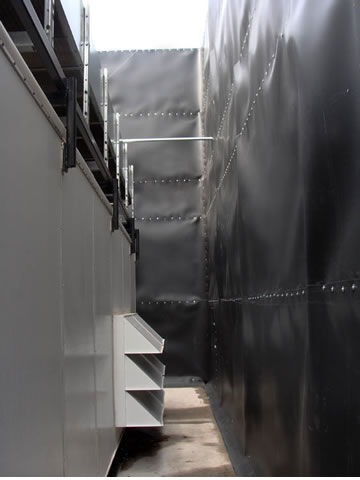Installation of a 24-foot noise barrier utilizing Acoustifence outdoor sound abatement material at the new Sheboygan Festival Foods store is complete, ending complaints from nearby residents over extreme levels of noise leaking from the store’s industrial refrigeration chillers into the community.
Folks in Sheboygen were celebrating when the popular Wisconsin-based Festival Foods grocery chain opened the 70,000 square foot mega store here on September 16, 2011. Less than two weeks later, the community’s warm welcome had grown icy as neighbors began to complain about noise from the store’s industrial refrigeration chiller that was so loud, it violated the city’s noise ordinance.
Festival Foods enlisted the help of Acoustical Engineer Eric Wolfram of Milwaukee-based Scott R. Riedel & Associates, LTD, who consulted with Acoustiblok’s Jay Boland to choose Acoustifence noise barrier material, a product of Acoustiblok, Inc. of Tampa Florida, to bring the decibel level down below the legal threshold and restore peace and quiet to the neighboring community.
When Wolfram first investigated the site in September, decibel readings ranged between 78.4 and 90.7, loud enough to be a risk for noise-related health problems to nearby residents and workers, had they been subjected to the noise over time. The Sheboygan Department of City Development demanded the level be reduced by at least five decibels, Wolfram said.
“The existing refrigeration pump and motor systems produce extreme noise levels,” Wolfram said. “This noise reverberates within the sheet-metal paneled enclosure interior and escapes through several different exhaust and ventilation openings.
“Additional noise was generated by the cooling and exhaust fans mounted above the enclosure.”
Working with sound consultants from Acoustiblok, Inc., Wolfram designed a two-step solution, creating a barrier with Acoustifence noise deadening material to block noise around the massive system, and incorporating another Acoustiblok product, QuietFiber, to help reduce sound from reflecting off of the taller adjacent building behind the chillers.
Minimal structural changes were required, as the ⅛- inch Acoustifence was easily attached to an existing chain link fence and the outdoor-rated QuietFiber with a perforated metal cover was capconed to the building.
The results were better than Wolfram had hoped, with decibel levels reduced to 57.3 the moment the barrier was in place – well below the City’s legal threshold, and more than 20 decibels lower than before the Acoustiblok products were installed. Neighbors are no longer bombarded with the irritating chiller noise, now replaced with the ordinary ambient sounds that existed before.
“Sounds from local traffic and roadways exceeded that of the compressor equipment after installation of the Acoustifence and QuietFiber products,” Wolfram said.
Lahnie Johnson, founder and president of Acoustiblok, Inc., applauded Festival Foods’ quick action in addressing the noise complaints right away, stating that the product combination was the perfect solution for this particular type of noise challenge.
“The Acoustifence and QuietFIber treatments were the perfect solution for the Festival Foods chiller noise, as both of these materials are designed to hold up in inclement weather, and as you can see from the results, they do their job well beyond everyone’s expectations,” Johnson said. “The Acoustifence and Quiet Fiber are also substantially less costly than attempting a structural enclosure solution.”
For more information on industrial noise solutions, visit the Acoustiblok website, Email sales@acoustiblok.com, or call 813-980-1400.
###
